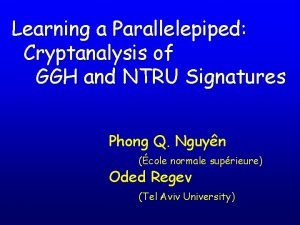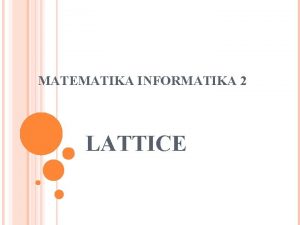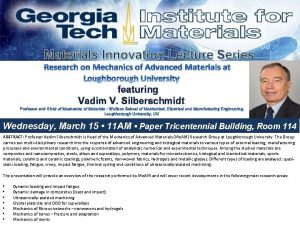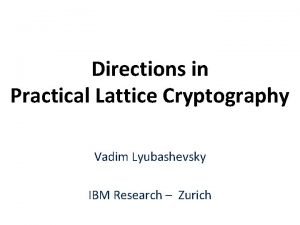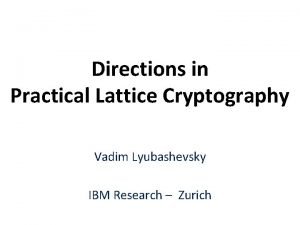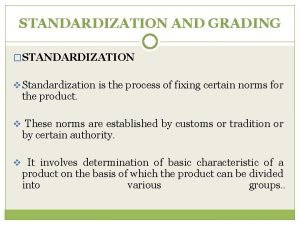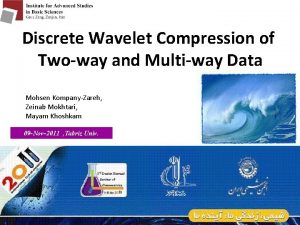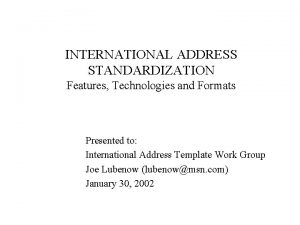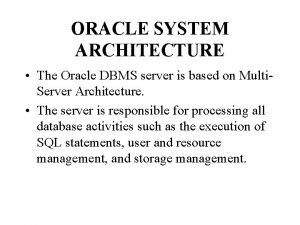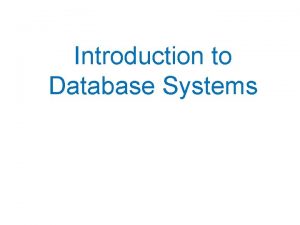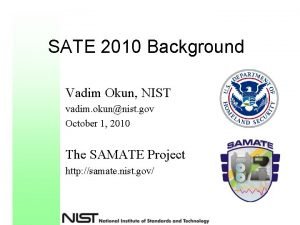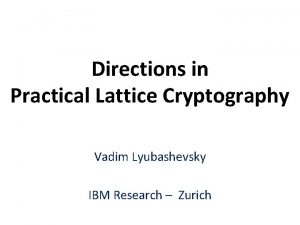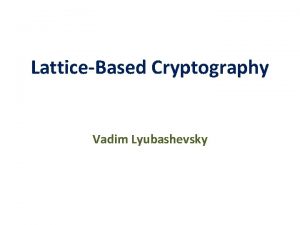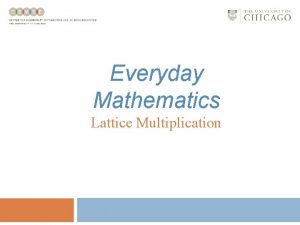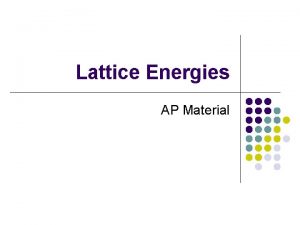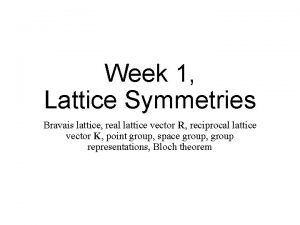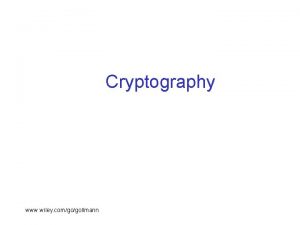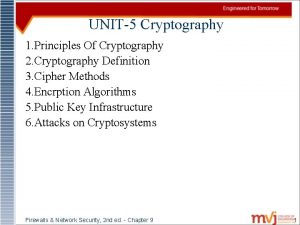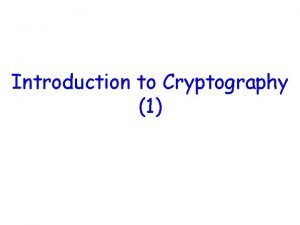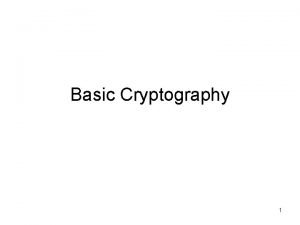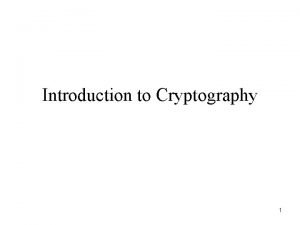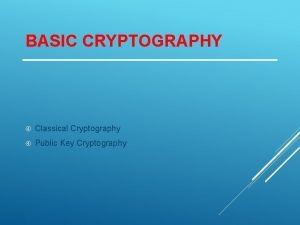Lattice Cryptography in the NIST Standardization Process Vadim







![Encryption Scheme Overview Inefficient Efficient [HPS ’ 98] NTRU Cryptosystem over Z[x]/(xn-1) NTRUPrime, NTRUEncrypt, Encryption Scheme Overview Inefficient Efficient [HPS ’ 98] NTRU Cryptosystem over Z[x]/(xn-1) NTRUPrime, NTRUEncrypt,](https://slidetodoc.com/presentation_image_h/e146e8f52089e884c8d5c07a27af377c/image-8.jpg)








![Encryption Scheme Overview Inefficient Efficient [HPS ’ 98] NTRU Cryptosystem over Z[x]/(xn-1) NTRUPrime, NTRUEncrypt, Encryption Scheme Overview Inefficient Efficient [HPS ’ 98] NTRU Cryptosystem over Z[x]/(xn-1) NTRUPrime, NTRUEncrypt,](https://slidetodoc.com/presentation_image_h/e146e8f52089e884c8d5c07a27af377c/image-17.jpg)


![Example Ring Z 17[x]/(x 4+1) Elements are z(x)=z 3 x 3+z 2 x 2+z Example Ring Z 17[x]/(x 4+1) Elements are z(x)=z 3 x 3+z 2 x 2+z](https://slidetodoc.com/presentation_image_h/e146e8f52089e884c8d5c07a27af377c/image-20.jpg)
![Example Ring Z 17[x]/(x 4+1) (X 3 - 2 X - 1)(-3 X 2 Example Ring Z 17[x]/(x 4+1) (X 3 - 2 X - 1)(-3 X 2](https://slidetodoc.com/presentation_image_h/e146e8f52089e884c8d5c07a27af377c/image-21.jpg)





![Encryption Scheme Overview Inefficient Efficient [HPS ’ 98] NTRU Cryptosystem over Z[x]/(xn-1) NTRUPrime, NTRUEncrypt, Encryption Scheme Overview Inefficient Efficient [HPS ’ 98] NTRU Cryptosystem over Z[x]/(xn-1) NTRUPrime, NTRUEncrypt,](https://slidetodoc.com/presentation_image_h/e146e8f52089e884c8d5c07a27af377c/image-27.jpg)



![Encryption Scheme Overview Inefficient Efficient [HPS ’ 98] NTRU Cryptosystem over Z[x]/(xn-1) NTRUPrime, NTRUEncrypt, Encryption Scheme Overview Inefficient Efficient [HPS ’ 98] NTRU Cryptosystem over Z[x]/(xn-1) NTRUPrime, NTRUEncrypt,](https://slidetodoc.com/presentation_image_h/e146e8f52089e884c8d5c07a27af377c/image-31.jpg)


![Digital Signature Overview [HHPSW ‘ 03] Use NTRU trapdoor for Signatures [Lyu ‘ 09] Digital Signature Overview [HHPSW ‘ 03] Use NTRU trapdoor for Signatures [Lyu ‘ 09]](https://slidetodoc.com/presentation_image_h/e146e8f52089e884c8d5c07a27af377c/image-34.jpg)
![“Fiat-Shamir with Aborts” [Lyu ‘ 09] … [BG ‘ 14] “Fiat-Shamir with Aborts” [Lyu ‘ 09] … [BG ‘ 14]](https://slidetodoc.com/presentation_image_h/e146e8f52089e884c8d5c07a27af377c/image-35.jpg)




![Digital Signature Overview [HHPSW ‘ 03] Use NTRU trapdoor for Signatures [Lyu ‘ 09] Digital Signature Overview [HHPSW ‘ 03] Use NTRU trapdoor for Signatures [Lyu ‘ 09]](https://slidetodoc.com/presentation_image_h/e146e8f52089e884c8d5c07a27af377c/image-40.jpg)
![Hash-and-Sign [HHPSW] [GVP] … FALCON Hash-and-Sign [HHPSW] [GVP] … FALCON](https://slidetodoc.com/presentation_image_h/e146e8f52089e884c8d5c07a27af377c/image-41.jpg)

![Digital Signature Overview [HHPSW ‘ 03] Use NTRU trapdoor for Signatures [Lyu ‘ 09] Digital Signature Overview [HHPSW ‘ 03] Use NTRU trapdoor for Signatures [Lyu ‘ 09]](https://slidetodoc.com/presentation_image_h/e146e8f52089e884c8d5c07a27af377c/image-43.jpg)






- Slides: 49

Lattice Cryptography in the NIST Standardization Process Vadim Lyubashevsky IBM Research – Zurich

Hard Problem Intuition A y z Given (A, z), find y Easy! Just invert A and multiply by z 2

Hard Problem Intuition A y e z Small coefficients Given (A, z), find (y, e) Seems hard. 3

Hard Problem Intuition (Learning With Errors) Small coefficients to enforce uniqueness Given (A, z), find (y, e) Seems hard. 4

Why is this “Lattice” Crypto?

Connection to Lattices • Solving a Lattice-Problem Breaking Cryptosystems • Breaking Cryptosystems Solving a Lattice Problem in all lattices § Worst-Case to Average-Case Reduction [Ajt ‘ 96, Reg ‘ 05, etc. ] § Asymptotically, the design of lattice-based schemes is sound

Lattice-Based Encryption
![Encryption Scheme Overview Inefficient Efficient HPS 98 NTRU Cryptosystem over Zxxn1 NTRUPrime NTRUEncrypt Encryption Scheme Overview Inefficient Efficient [HPS ’ 98] NTRU Cryptosystem over Z[x]/(xn-1) NTRUPrime, NTRUEncrypt,](https://slidetodoc.com/presentation_image_h/e146e8f52089e884c8d5c07a27af377c/image-8.jpg)
Encryption Scheme Overview Inefficient Efficient [HPS ’ 98] NTRU Cryptosystem over Z[x]/(xn-1) NTRUPrime, NTRUEncrypt, NTRU-HSS, etc. [Mic ’ 02, LM ‘ 06, PR ‘ 06] Basic Constructions over Z[x]/(f(x)) [Ajt ’ 96, AD ‘ 97] Basic CRH and Cryptosystem over Z [LPR ‘ 10] Ring-LWE and Practical Cryptosystem over Z[x]/(f(x)) [Reg ’ 05] Learning with Errors Cryptosystem over Z New. Hope, Kyber, Round 2, Saber, etc … Frodo, Lizard, etc.

Key Exchange / CCA – Encryption/ Authenticated Key Exchange CPA-Secure PKE All “black-box” transformations CCA-Secure KEM CCA-Secure PKE Key Exchange Authenticated Key Exchange

Encryption from LWE

Encryption Scheme A Zqn x n s + = t r Small Coeffs. A + Small Coeffs. Public Key A is random – can be created as H(seed) t + 0 m = u v

Encryption Scheme A s + = t r A t + + Is pseudo-random based on the hardness of the Learning with Errors Problem 0 m = u v

Encryption Scheme A s + r = t A t + + v = + r A = s + + r A + s + m m 0 m = u v

Encryption Scheme A s + r = t A t + + u = r A s = + s + r A s ≈ v - m 0 m = u v

Encryption Scheme A r = t s + A t + + v - = u s + m represent 0 by m=0 represent 1 by m=(q-1)/2 0 m = u v Encrypts only 1 bit – large ciphertext expansion 1 bit requires n elements in Zq

Encrypting More Bits A S + = T k R A T + k + Encrypting k 2 bits requires nk elements in Z i. e. n/k elements in Zq per bit q 0 M = U V
![Encryption Scheme Overview Inefficient Efficient HPS 98 NTRU Cryptosystem over Zxxn1 NTRUPrime NTRUEncrypt Encryption Scheme Overview Inefficient Efficient [HPS ’ 98] NTRU Cryptosystem over Z[x]/(xn-1) NTRUPrime, NTRUEncrypt,](https://slidetodoc.com/presentation_image_h/e146e8f52089e884c8d5c07a27af377c/image-17.jpg)
Encryption Scheme Overview Inefficient Efficient [HPS ’ 98] NTRU Cryptosystem over Z[x]/(xn-1) NTRUPrime, NTRUEncrypt, NTRU-HSS, etc. [Mic ’ 02, LM ‘ 06, PR ‘ 06] Basic Constructions over Z[x]/(f(x)) [Ajt ’ 96, AD ‘ 97] Basic CRH and Cryptosystem over Z [LPR ‘ 10] Ring-LWE and Practical Cryptosystem over Z[x]/(f(x)) [Reg ’ 05] Learning with Errors Cryptosystem over Z New. Hope, Kyber, Round 2, Saber, etc … Frodo, Lizard, etc. PK, ciphertext ~ 10 KB

Encryption from (polynomial / ring / generalized / module)-LWE

Hard Problem Intuition (Generalized / Ring / Module-LWE) Use Polynomial Rings Instead of Integers 19
![Example Ring Z 17xx 41 Elements are zxz 3 x 3z 2 x 2z Example Ring Z 17[x]/(x 4+1) Elements are z(x)=z 3 x 3+z 2 x 2+z](https://slidetodoc.com/presentation_image_h/e146e8f52089e884c8d5c07a27af377c/image-20.jpg)
Example Ring Z 17[x]/(x 4+1) Elements are z(x)=z 3 x 3+z 2 x 2+z 1 x+z 0 where zi are integers mod 17 Addition is the usual coordinate-wise addition Multiplication is the usual polynomial multiplication followed by reduction modulo x 4+1 20
![Example Ring Z 17xx 41 X 3 2 X 13 X 2 Example Ring Z 17[x]/(x 4+1) (X 3 - 2 X - 1)(-3 X 2](https://slidetodoc.com/presentation_image_h/e146e8f52089e884c8d5c07a27af377c/image-21.jpg)
Example Ring Z 17[x]/(x 4+1) (X 3 - 2 X - 1)(-3 X 2 + 6) = (-3 X 5 + 12 X 3 +3 X 2 -12 X - 6) = (3 X + 12 X 3 + 3 X 2 -12 X - 6) = (-5 X 3 +3 X 2 +8 X -6) Important: Reductions modulo X 4+1 do not increase the coefficients! (For some moduli, there could be an exponential increase – these are not useful for crypto). 21

Encrypting More Bits A r = t s + A t + + v - = u s + m 0 m = u v Instead of 1 element in Z, make it 1 element in Z[X]/(Xd+1) i. e. work over R=Zq[X]/(Xd+1) instead of Zq An encryption of d integers.

A Encryption Scheme Over Polynomial Rings r s + = t A t + Rq 3 x 3 + 0 u s = + m 0 - u 0 v m = v

Operations in CRYSTALS (our lattice suite submission to NIST) Basic Computational Domain: Polynomial ring Zp[x]/(x 256+1) Operations used in the schemes: and in the ring: small coefficients

Operations in CRYSTALS Only two main operations needed (and both are very fast): 1. Evaluations of SHAKE (can use another XOF too) 2. Add / multiply in the polynomial ring Zp[X]/(X 256+1) • • p = 213 – 29 + 1 (for KEM / Encryption Kyber) p = 223 – 213 + 1 (for Signature Dilithium) To increase security, just do more of the same operations The exact same hardware/software can be reused 25

Modular security 768 -dim to increase the security margin 1024 -dim
![Encryption Scheme Overview Inefficient Efficient HPS 98 NTRU Cryptosystem over Zxxn1 NTRUPrime NTRUEncrypt Encryption Scheme Overview Inefficient Efficient [HPS ’ 98] NTRU Cryptosystem over Z[x]/(xn-1) NTRUPrime, NTRUEncrypt,](https://slidetodoc.com/presentation_image_h/e146e8f52089e884c8d5c07a27af377c/image-27.jpg)
Encryption Scheme Overview Inefficient Efficient [HPS ’ 98] NTRU Cryptosystem over Z[x]/(xn-1) NTRUPrime, NTRUEncrypt, NTRU-HRSS, etc. [Mic ’ 02, LM ‘ 06, PR ‘ 06] Basic Constructions over Z[x]/(f(x)) [Ajt ’ 96, AD ‘ 97] Basic CRH and Cryptosystem over Z [LPR ‘ 10] Ring-LWE and Practical Cryptosystem over Z[x]/(f(x)) [Reg ’ 05] Learning with Errors Cryptosystem over Z Kyber, Round 2, Saber, etc. PK, ciphertext ~ 1 KB Frodo, Lizard, etc. PK, ciphertext ~ 10 KB

NTRU Encryption

NTRU Cryptosystem f f g g = a Small secret keys u =2 a r + mod p “looks” random If a is random, then pseudorandom based on Ring-LWE u g = 2 f u g mod 2 = u g mod 2 g + m r + = g + g m m mod p

Comparison (they’re virtually the same) A t a=f/g H(seed) • t and a have the same size. But A=H(seed) needs to be re-generated • Cannot efficiently make the NTRU public key consist of more polynomials • f/g may be costlier to compute – makes a difference in ephemeral key exchange u v u The u have the same size. Only the high-order bits of v need to be transmitted.
![Encryption Scheme Overview Inefficient Efficient HPS 98 NTRU Cryptosystem over Zxxn1 NTRUPrime NTRUEncrypt Encryption Scheme Overview Inefficient Efficient [HPS ’ 98] NTRU Cryptosystem over Z[x]/(xn-1) NTRUPrime, NTRUEncrypt,](https://slidetodoc.com/presentation_image_h/e146e8f52089e884c8d5c07a27af377c/image-31.jpg)
Encryption Scheme Overview Inefficient Efficient [HPS ’ 98] NTRU Cryptosystem over Z[x]/(xn-1) NTRUPrime, NTRUEncrypt, NTRU-HRSS PK, ciphertext ~ 1 KB [Mic ’ 02, LM ‘ 06, PR ‘ 06] Basic Constructions over Z[x]/(f(x)) [Ajt ’ 96, AD ‘ 97] Basic CRH and Cryptosystem over Z [LPR ‘ 10] Ring-LWE and Practical Cryptosystem over Z[x]/(f(x)) [Reg ’ 05] Learning with Errors Cryptosystem over Z Kyber, Round 2, Saber, etc. PK, ciphertext ~ 1 KB Frodo, Lizard, etc. PK, ciphertext ~ 10 KB

Small Variations Schemes made slightly more efficient by more “aggressive” constructions • e. g. using secret / noise coefficients in a smaller range • Instead of adding noise, doing rounding (chopping off bits) Unclear if there is any security penalty Analogous to saying: “I made SHA-3 more efficient by changing the compression function from 24 to 20 rounds”

Digital Signatures
![Digital Signature Overview HHPSW 03 Use NTRU trapdoor for Signatures Lyu 09 Digital Signature Overview [HHPSW ‘ 03] Use NTRU trapdoor for Signatures [Lyu ‘ 09]](https://slidetodoc.com/presentation_image_h/e146e8f52089e884c8d5c07a27af377c/image-34.jpg)
Digital Signature Overview [HHPSW ‘ 03] Use NTRU trapdoor for Signatures [Lyu ‘ 09] “Fiat-Shamir with Aborts” Digital Signature (All are Zero-Knowledge in the QROM) [GPV ‘ 08] Made it Secure via Gaussian Sampling [DP ‘ 16] Made it Efficient [Lyu ‘ 12] Gaussian Rejection Sampling SIS + LWE Based [GLP ‘ 12] [BG ‘ 14], TESLA Signature Compression FALCON BLISS [DDLL ‘ 13] Bimodal Gaussian Sampling Dilithium Public Key + Signature Compression Based on NTRU Uses Discrete Gaussian Sampling Additionally useful for IBE Based on (Module-) LWE / SIS Uses Uniform Sampling Additionally useful for ZK-Proofs Signature Size
![FiatShamir with Aborts Lyu 09 BG 14 “Fiat-Shamir with Aborts” [Lyu ‘ 09] … [BG ‘ 14]](https://slidetodoc.com/presentation_image_h/e146e8f52089e884c8d5c07a27af377c/image-35.jpg)
“Fiat-Shamir with Aborts” [Lyu ‘ 09] … [BG ‘ 14]

Public / Secret Keys Public key A: =XOF(seed) uniform mod p Secret key s 1, s 2 with small coefficients Public key t: =As 1+s 2

Signing and Verification As 1+s 2=t Sign(μ) Verify(z, c, μ) y Coefficients in [-γ, γ] c : = H(high(Ay), μ) Check that |z| ≤ γ – β Needed for security z : = y + cs 1 and If |z| > γ – β or |low(Ay - cs 2)|> γ – β c=H(high(Az - ct) , μ) restart Signature = (z, c) Correct because high(Ay) = high(Az - ct)

Removing Low-Order PK bits As 1+s 2=t 0+bt 1 Sign(μ) Verify(z, c, μ) y Coefficients in [-γ, γ] c : = H(high(Ay), μ) Check that |z| ≤ γ – β z : = y + cs 1 and If |z| > γ – β or |low(Ay - cs 2)|> γ – β c=H(high(Az - cbt 1) , μ) restart Az - ct + ct 0 Signature = (z, c) Want high(Ay) = high(Az - ct + ct 0) Give out “carries” caused by ct 0 as hints

Dilithium (high-level overview) Sign(μ) As 1+s 2=t 0+bt 1 Verify(z, c, μ) y Coefficients in [-γ, γ] c : = H(high(Ay), μ) z : = y + cs 1 Check that |z| ≤ γ – β If |z| > γ – β or |low(Ay - cs 2)|> γ – β and restart c=H(high(h “+” Az - cbt 1) , μ) Create carry bit hint vector h Signature = (z, h, c) high(Ay) Hint h • adds 100 – 200 bytes to the signature • Saves ≈ 2 KB in the public key
![Digital Signature Overview HHPSW 03 Use NTRU trapdoor for Signatures Lyu 09 Digital Signature Overview [HHPSW ‘ 03] Use NTRU trapdoor for Signatures [Lyu ‘ 09]](https://slidetodoc.com/presentation_image_h/e146e8f52089e884c8d5c07a27af377c/image-40.jpg)
Digital Signature Overview [HHPSW ‘ 03] Use NTRU trapdoor for Signatures [Lyu ‘ 09] “Fiat-Shamir with Aborts” Digital Signature (All are Zero-Knowledge in the QROM) [GPV ‘ 08] Made it Secure via Gaussian Sampling [DP ‘ 16] Made it Efficient [Lyu ‘ 12] Gaussian Rejection Sampling SIS + LWE Based [GLP ‘ 12] [BG ‘ 14], TESLA Signature Compression FALCON BLISS [DDLL ‘ 13] Bimodal Gaussian Sampling Dilithium PK: 1. 5 KB Sig: 2. 7 KB Based on NTRU Uses Discrete Gaussian Sampling Additionally useful for IBE Based on (Module-) LWE / SIS Uses Uniform Sampling Additionally useful for ZK-Proofs Signature Size
![HashandSign HHPSW GVP FALCON Hash-and-Sign [HHPSW] [GVP] … FALCON](https://slidetodoc.com/presentation_image_h/e146e8f52089e884c8d5c07a27af377c/image-41.jpg)
Hash-and-Sign [HHPSW] [GVP] … FALCON

FALCON a y e z Small coefficients z=H(message) Signer has a “trapdoor” that allows him to find short y, e for any z Signing does not leak anything about the trapdoor 42
![Digital Signature Overview HHPSW 03 Use NTRU trapdoor for Signatures Lyu 09 Digital Signature Overview [HHPSW ‘ 03] Use NTRU trapdoor for Signatures [Lyu ‘ 09]](https://slidetodoc.com/presentation_image_h/e146e8f52089e884c8d5c07a27af377c/image-43.jpg)
Digital Signature Overview [HHPSW ‘ 03] Use NTRU trapdoor for Signatures [Lyu ‘ 09] “Fiat-Shamir with Aborts” Digital Signature (All are Zero-Knowledge in the QROM) [GPV ‘ 08] Made it Secure via Gaussian Sampling [DP ‘ 16] Made it Efficient [Lyu ‘ 12] Gaussian Rejection Sampling SIS + LWE Based [GLP ‘ 12] [BG ‘ 14], TESLA Signature Compression FALCON PK: 0. 900 / 1. 8 KB Sig: 0. 6 / 1. 2 KB BLISS [DDLL ‘ 13] Bimodal Gaussian Sampling Dilithium PK: 1. 5 KB Sig: 2. 7 KB Based on NTRU Uses Discrete Gaussian Sampling Additionally useful for IBE Based on (Module-) LWE / SIS Uses Uniform Sampling Additionally useful for ZK-Proofs Signature Size

Personal PQ-Recommendations • If you want minimal assumptions: • Encryption / Key Exchange: Frodo (or something like it based on LWE) • Signature: SPHINCS (or something like it using Merkle trees) • If you care about efficiency: • Encryption / Key Exchange: Kyber (or some other 1 KB equivalent) • Signature: Dilithium

Lattice Problems Leads to the smallest: • pk + ciphertext for encryption (except for isogeny-based crypto, but lattices are much faster right now) • pk + signature for digital signatures

Lattice Problems The most analyzed post-quantum assumption (against classical and quantum algorithms) • Lovasz, Lenstra H. , Lenstra A. , Babai, Schnorr, Coppersmith, Shamir, Regev, Shor, etc. all worked on lattice algorithms or attacks against some lattice cryptoscheme • No breakthrough novel techniques since LLL • Cryptanalysis using known techniques is believed to be approaching a lower bound

Performance Comparisons PK Size Cipher Size Key. Gen Cycles Enc. Cycles Dec. Cycles Frodo 11 KB 1200 K 1800 K Kyber 1. 1 KB 1. 2 KB 85 K 110 K PK Size Sign Cycles Verify Cycles SPHINCS 1 KB 40 KB 50, 000 K 1, 500 K Dilithium 1. 5 KB 2. 7 KB 500 K 175 K

Action Recommendations • If you need post-quantum crypto now, don’t wait for NIST standards • Many proposals are just small variants of well-studied problems (no breakthrough ideas in lattice crypto) • Pick something and use it in tandem with current crypto • Europe can create its own set of standards in under a year “The enemy of a good plan is the dream of a perfect plan”

Thank You.
 Ggh
Ggh Poset lattice
Poset lattice Data standardization process
Data standardization process Vadim java
Vadim java Vadim grechushkin
Vadim grechushkin Vadim trunov photo
Vadim trunov photo Etnoi
Etnoi Vadim v. silberschmidt
Vadim v. silberschmidt Mary luana williams
Mary luana williams Vadim lyubashevsky
Vadim lyubashevsky Vadim bulitko
Vadim bulitko Vadim trunov montage
Vadim trunov montage Vadim bulitko
Vadim bulitko Vadim lyubashevsky
Vadim lyubashevsky Vadim oswalt
Vadim oswalt Standardization statistics
Standardization statistics Grading means
Grading means Milk standardization formula
Milk standardization formula Preparation and standardization of potassium permanganate
Preparation and standardization of potassium permanganate Standardization of outputs
Standardization of outputs Objective of product and service design
Objective of product and service design Architectural models for distributed dbms
Architectural models for distributed dbms Trillium software system competitors
Trillium software system competitors Standardization of psychological test
Standardization of psychological test Standardization of outputs
Standardization of outputs Address quality software
Address quality software Test construction and standardization
Test construction and standardization Define standardized recipe
Define standardized recipe Indirect standardization
Indirect standardization Nato standardization office
Nato standardization office Direct standardization example
Direct standardization example Emirates authority for standardization and metrology logo
Emirates authority for standardization and metrology logo Standardization in oil and gas industry
Standardization in oil and gas industry Kaizen standardization
Kaizen standardization The quantified recipe must be tested and standardized
The quantified recipe must be tested and standardized How to pronounce standardization
How to pronounce standardization World telecommunication standardization assembly
World telecommunication standardization assembly International address formats
International address formats Nato standardization office
Nato standardization office Dbms system architecture
Dbms system architecture Dbms standardization
Dbms standardization Www.iso
Www.iso Vertical product differentiation
Vertical product differentiation Standardization in product and service design
Standardization in product and service design International organization for standardization
International organization for standardization Hát kết hợp bộ gõ cơ thể
Hát kết hợp bộ gõ cơ thể Bổ thể
Bổ thể Tỉ lệ cơ thể trẻ em
Tỉ lệ cơ thể trẻ em Gấu đi như thế nào
Gấu đi như thế nào
